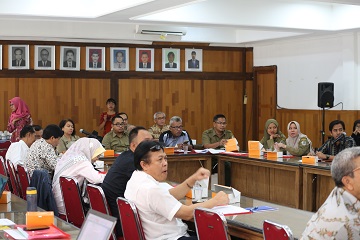IPB Faculty of Forestry Holds Risk Management Discussion in Conservation Areas and Disaster Prone Areas

The Department of Forest Resources Conservation and Ecotourism (KSHE) of the Faculty of Forestry, Bogor Agricultural University (IPB Fahutan) held a discussion on "Risk Management in Conservation Areas and Disaster Prone Areas" located in the Sylva Meeting Room of the Faculty of Forestry of IPB, Dramaga Campus of IPB Bogor (28/8 ) Indonesia is blessed with mountains, forests, oceans, rivers and lakes that are interesting to be used as tourist destinations. And one of the requirements in the management of natural tourism is the safety of visitors.
Dean of the Faculty of Forestry, IPB, Dr. Rinekso Soekmadi said that a very interesting Indonesian ecotourism area was in a disaster-prone area that could threaten visitors' safety, so this condition needs more attention.
"The purpose of this discussion is to collect information and data from various institutions in managing ecotourism hazards in conservation areas and disaster-prone areas. Hopefully there are further steps from the parties in managing the ecotourism danger in conservation areas and disaster-prone areas, so that Indonesia can be known as a country that pays attention to the safety or safety of visitors, "said Rinekso Soekmadi.
The result of this discussion was the study of several mountains and beaches including Mount Bromo, Mount Merapi, Mount Rinjani and Mount Agung. While the beaches are Pelabuhan Ratu, Parangtritis, Suwuk and Tanjung Setia Krui.
For example, Mount Rinjani National Park (TNGR), is a very popular ecotourism destination for mountain climbing in West Nusa Tenggara (NTB). Before the earthquake occurred, Mount Rinjani itself was a mountain whose natural conditions needed special attention, ranging from tracks to the peaks and craters, as well as frequent accidents. For mechanisms in the event of an accident, the manager has begun collaboration with EMHC (Edelweis Medical Help Center) in the form of an insurance and funds used for treatment in the event of an accident, from picking up on the mountain, starting treatment to being referred to a hospital.
Other examples are at Parangtritis beach and Palabuhan Ratu beach. Beach accidents are often associated with public trust associated with Nyai Roro Kidul. Even though the accident actually happened because of certain currents that were not recognized by visitors and the absence or lack of effort to provide early warning to visitors to avoid accidents.
"Until now the mechanism in the event of a hazard has already begun to be carried out, but it is generally carried out as a safety measure in the event of an accident. Whereas actions for prevention or preventive actions are still lacking or only few have been done. Likewise in various ecotourism places in Indonesia, usually what is currently available is action or handling after an accident. The views or perceptions of the parties who should be responsible for ecotourism activities are still very diverse, "said Rinekso Soekmadi.
Meanwhile, the potential danger of eruption or volcanic activity is found in all four locations with different risks. Eruptions on Mount Merapi have the highest risk level compared to the other three locations (Mount Bromo, Mount Rinjani and Gunung Agung) which are at risk of being accepted or tolerated. Landslide hazards are found in all four locations with low risk (tolerable risk). Steep slopes on the hiking trail pose moderate risk to Mount Merapi and Mount Rinjani, but provide substantial risk to Mount Bromo and Mount Agung. Activity or negligence of visitors has a substantial risk on Mount Bromo, Mount Rinjani and Mount Agung. Biological hazards are found more on Mount Rinjani and tree roots provide moderate risk for visitors.
At three coastal locations (Palabuhan Ratu, Suwuk, and Parangtritis), rip flows are potential with substantial risk. But at Tanjung Setia Beach a substantial risk for recreational visitors is caused by waves of hatchlings. Jellyfish is the only biological hazard that is found in all four coastal locations, but has a higher risk in Suwuk Beach than the other three beaches.
Various things can be done to improve the effectiveness of hazard management. One of the focuses is visitors who directly experience losses from accidents that occur to him. Negligence of visitors in carrying out their activities often makes the risk of danger becomes higher. Visitors often neglect to comply with the appeals or warnings given by the manager. Therefore, education for visitors is an important thing that can improve the effectiveness of hazard management that is applied by the manager.
"So the hazard management mechanism in an ecotourism area must involve the parties collaboratively to be able to deal with hazards quickly and coordinated. If an ecotourism area experiences a disaster, the coordination mechanism has also been determined, who is responsible, what and who will be the leader in that condition. Ideally, in an ecotourism area, it is necessary to map the existence of hazards that are in normal / normal conditions and in conditions of disaster, "added Rinekso Soekmadi.
This activity was attended by stakeholders in charge of ecotourism in Indonesia including, Head of Department KSHE Fahutan IPB, Dr. Ir. Nyoto Santoso, Lecturer of the Department of Forest Conservation and Ecotourism, Fahutan IPB, Prof. Dr. EKSHarini Muntasib, Directorate General of Regional Development, Ministry of Home Affairs, Amanda, Environmental and Forestry Standardization Center, Dwi Haryanto, Bogor Regional Disaster Management Agency (BPBD), Hendra, Indonesian Ministry of Environment and Forestry, Ika Puspita, Gunung Gede National Park Pangrango, Fitra, Gunung Gede Merapi Park, Ruky Unaya, Meteorology, Climatology and Geophysics Agency (BMKG), Asri Rachmawati, and researchers and lecturers from KSHE IPB. (jhn)


